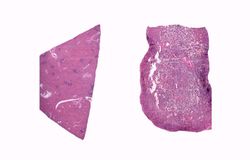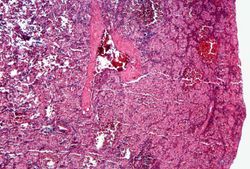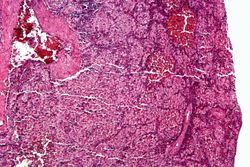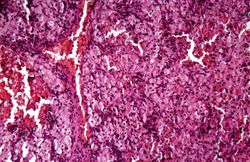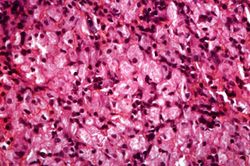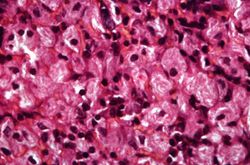Difference between revisions of "IPLab:Lab 5:Gaucher Disease"
Seung Park (talk | contribs) |
(→Autopsy Findings) |
||
| (7 intermediate revisions by 2 users not shown) | |||
| Line 1: | Line 1: | ||
| − | == Clinical Summary | + | == Clinical Summary == |
| − | This 23-year-old | + | This 23-year-old female went to her doctor because of chronic fatigue, bone pain, and easy bruising and frequent nose bleeds. Physical exam demonstrated hepatomegaly and splenomegaly and lab results demonstrated anemia and thrombocytopenia. Biopsy and further workup led to a diagnosis of Gaucher disease. |
| − | + | Despite appropriate therapy the anemia and thrombocytopenia persisted as well as the severe splenomegaly. A splenectomy was performed. The surface of the spleen was pale and roughly granular. The cut surface revealed the same pale appearance. | |
| − | |||
== Images == | == Images == | ||
| Line 16: | Line 15: | ||
File:IPLab5Gaucher8.jpg|This is a higher-power photomicrograph of the spleen from this case. At this higher power individual cells can be better appreciated and the fibrillar nature of the eosinophilic cytoplasmic material can be seen. | File:IPLab5Gaucher8.jpg|This is a higher-power photomicrograph of the spleen from this case. At this higher power individual cells can be better appreciated and the fibrillar nature of the eosinophilic cytoplasmic material can be seen. | ||
</gallery> | </gallery> | ||
| + | |||
| + | == Virtual Microscopy == | ||
| + | <peir-vm>IPLab5Gaucher</peir-vm> | ||
== Study Questions == | == Study Questions == | ||
| Line 25: | Line 27: | ||
The third pattern, type III, is usually somewhat intermediate between types I and II. These patients are usually juveniles and have systemic involvement like in type I but they have progressive central nervous system disease that usually begins in the second or third decade of life.</spoiler> | The third pattern, type III, is usually somewhat intermediate between types I and II. These patients are usually juveniles and have systemic involvement like in type I but they have progressive central nervous system disease that usually begins in the second or third decade of life.</spoiler> | ||
* <spoiler text="What type of Gaucher disease did this patient likely have?">This was an adult who had pancytopenia and aseptic necrosis of bone. This is consistent with type I. In type I symptoms and signs first appear in adult life and are related to splenomegaly or to bone involvement by Gaucher cells. These patients have pancytopenia or thrombocytopenia secondary to hypersplenism and pathologic fractures and bone pain due to expansion of the marrow space by Gaucher cells.</spoiler> | * <spoiler text="What type of Gaucher disease did this patient likely have?">This was an adult who had pancytopenia and aseptic necrosis of bone. This is consistent with type I. In type I symptoms and signs first appear in adult life and are related to splenomegaly or to bone involvement by Gaucher cells. These patients have pancytopenia or thrombocytopenia secondary to hypersplenism and pathologic fractures and bone pain due to expansion of the marrow space by Gaucher cells.</spoiler> | ||
| + | |||
| + | == Additional Resources == | ||
| + | === Reference === | ||
| + | * [http://emedicine.medscape.com/article/944157-overview eMedicine Medical Library: Gaucher Disease] | ||
| + | * [http://www.merckmanuals.com/professional/hematology_and_oncology/spleen_disorders/splenomegaly.html Merck Manual: Splenomegaly] | ||
| + | * [http://www.merckmanuals.com/professional/pediatrics/inherited_disorders_of_metabolism/lysosomal_storage_disorders.html Merck Manual: Lysosomal Storage Disorders] | ||
| + | |||
| + | === Journal Articles === | ||
| + | * Barone R, Pavone V, Nigro F, Chabàs A, Fiumara A. [http://www.ncbi.nlm.nih.gov/pubmed/10792292 Extraordinary bone involvement in a gaucher disease type I patient]. ''Br J Haematol'' 2000 Mar;108(4):838-41. | ||
| + | |||
| + | === Images === | ||
| + | * [{{SERVER}}/library/index.php?/tags/1670-gaucher_cell PEIR Digital Library: Gaucher Cell Images] | ||
| + | * [http://library.med.utah.edu/WebPath/HEMEHTML/HEMEIDX.html Webpath: Hematopathology] | ||
{{IPLab 5}} | {{IPLab 5}} | ||
[[Category: IPLab:Lab 5]] | [[Category: IPLab:Lab 5]] | ||
Latest revision as of 19:52, 8 July 2020
Contents
Clinical Summary[edit]
This 23-year-old female went to her doctor because of chronic fatigue, bone pain, and easy bruising and frequent nose bleeds. Physical exam demonstrated hepatomegaly and splenomegaly and lab results demonstrated anemia and thrombocytopenia. Biopsy and further workup led to a diagnosis of Gaucher disease.
Despite appropriate therapy the anemia and thrombocytopenia persisted as well as the severe splenomegaly. A splenectomy was performed. The surface of the spleen was pale and roughly granular. The cut surface revealed the same pale appearance.
Images[edit]
Virtual Microscopy[edit]
Study Questions[edit]
Additional Resources[edit]
Reference[edit]
- eMedicine Medical Library: Gaucher Disease
- Merck Manual: Splenomegaly
- Merck Manual: Lysosomal Storage Disorders
Journal Articles[edit]
- Barone R, Pavone V, Nigro F, Chabàs A, Fiumara A. Extraordinary bone involvement in a gaucher disease type I patient. Br J Haematol 2000 Mar;108(4):838-41.
Images[edit]
| |||||
Trauma (from fracture or surgery) is one cause of asceptic (or avascular) necrosis of bone, which is defined as the death of bone and bone marrow in the abscence of an infectious agent.


